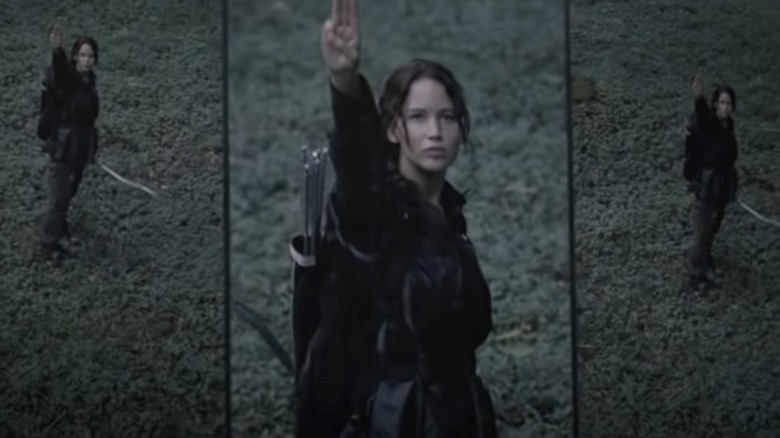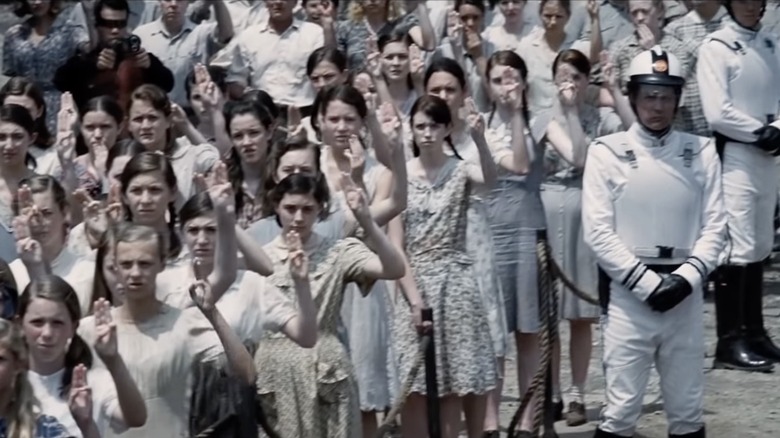What The Three Finger Salute Really Means In The Hunger Games
In the movie series "The Hunger Games," based on the novels by Suzanne Collins and starring Jennifer Lawrence, some of the most moving moments on-screen come from times when Katniss Everdeen (Jennifer Lawrence) and others use the three-finger salute. The characters live in an unjust society where, every year, a boy and a girl from each district in Panem are chosen to compete in what basically amounts to a dystopian reality competition. Only one person out of the 24 chosen contestants will survive and win, which means this is a death sentence for many of the young people who come from the poorer districts.
The three-finger salute first happens in "The Hunger Games" when Katniss takes her younger sister Prim's (Willow Shields) place at the Reaping in District 12. Later in that movie, Katniss uses it when Rue (Amandla Stenberg) dies, giving the three-finger salute to the camera she knows is watching them. Spectators watching from a crowd in District 11, another poor and oppressed region, respond with their own salutes, then start a riot protesting the death of the young girl and their powerlessness in Panem.
But what, exactly, does the three-finger salute mean?
It means respect and goodbye to one you love, but also gained meaning in this oppressive society
In the book, Katniss explains the gesture when she first sees the crowd using it to salute her at the Reaping. "At first one, then another, then almost every member of the crowd touches the three middle fingers of their left hand to their lips and holds it out to me," author Collins writes. "It is an old and rarely used gesture of our district, occasionally seen at funerals. It means thanks, it means admiration, it means good-bye to someone you love."
Over the course of the series, though, the three-finger salute also — and perhaps inevitably — began to have a larger meaning. In the second movie, "The Hunger Games: Catching Fire," the gesture is used after Katniss makes a speech remembering Rue. "I couldn't save her," she says, prompting an older man in the audience to whistle the notes of Rue's song and then use the three-finger salute. The crowd follows suit, but enforcers make their way into the crowd and execute the man with a shot to the head. Clearly, the salute at this point is being seen as a sign of resistance, of rebellion against the capital, and of support for justice. The use of it results in immediate, irrevocable punishment, which shows how dangerous the powers-that-be find it.
The origins of the three-finger salute ... and real-world implications
The three-finger salute didn't originate with Collins. It actually has its origins in a similar salute from the Girl Guides and the Boy Scouts, where it's used when the Boy Scout Oath and Law are recited and when people wish to quiet a room. It has reportedly been around since 1908. However, since then it has taken on a new meaning, as a result of its higher prominence in "The Hunger Games" trilogy.
In Thailand, it was used in 2014 following a military coup, then banned by the ruling military junta as part of efforts to stem the tide of outrage that followed the bloodless takeover. Protestors told the Guardian that each finger stood for the values of the French revolution: liberty, equality, fraternity. Alternatively, the fingers are said to mean freedom, elections, and democracy. Sirawith Seritiwat, a Thai pro-democracy activist, directly referenced the movie when discussing the salute with The Guardian in 2014. He said, "It was partly because the anti-coup situation back then felt similar to scenes in the 'Hunger Games' film, where people put three fingers up towards President Snow." However, a Guardian columnist believed that co-opting a symbol from a mass entertainment pointed to "a bankruptcy of political beliefs in the 21st century."
Earlier this year, the symbol was also used at protests in Myanmar (also via The Guardian), when the elected government of Aung San Suu Kyi was overthrown by a military junta following what it deemed to be fraudulent elections in November 2020. So its efficacy as a sign of resistance remains.
Interestingly, Collins was apparently inspired by classical antiquity, and specifically the gladiatorial games of Roman times (per The New York Times), when writing "The Hunger Games," which has led some (like Screen Rant) to wonder if the three-finger salute is based on the Roman salute. In a fascinating twist of irony, though, the Roman salute isn't really from Rome. It originates from films (sound familiar?) and plays about earlier eras, and has actually been co-opted as a symbol by totalitarian regimes, like the Fascists and Nazis (via the International Journal of the Classical Tradition).


